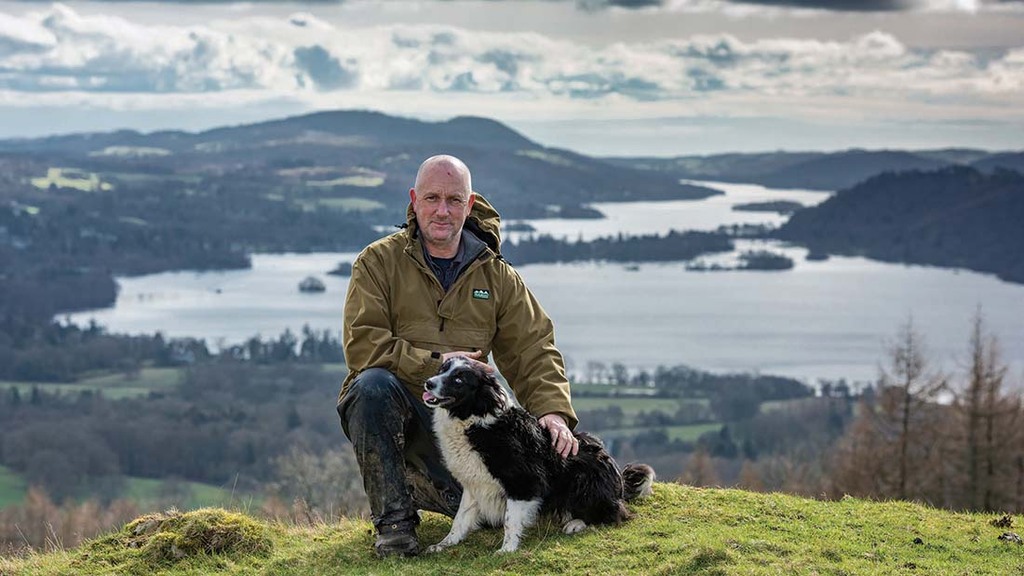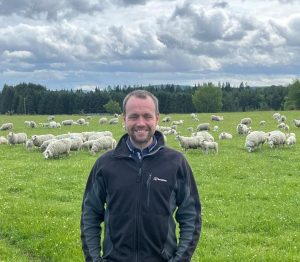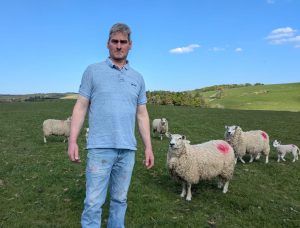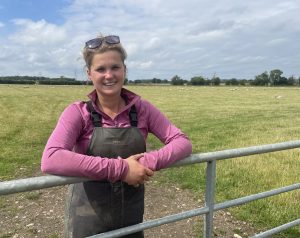As featured in The Farmers Guardian
Third generation farmer Pip Simpson, runs Poole Bank Farm in the village of Troutbeck, situated near Lake Windermere in the Lake District National Park.
The family were originally tenant farmers, but over the last 20 years Mr Simpson has built up his assets and now owns 243 hectares, (600 acres) of land at the farm and rents a further 303ha (750 acres) in associated grazing agreements and tenancies.
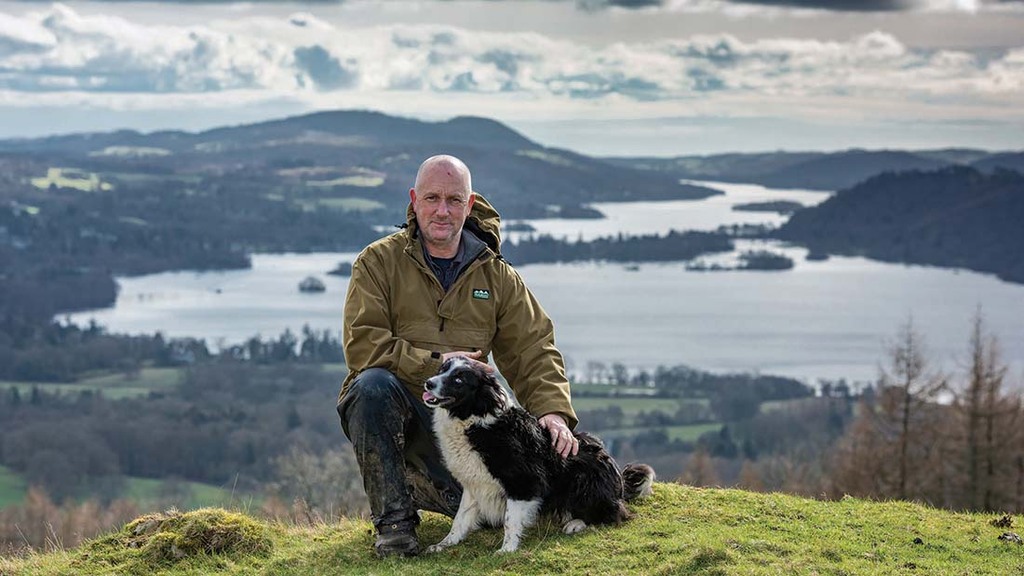
His partner, Hannah Towers, works as a land agent four days a week and helps out on the farm with their four-year-old son Ted, when she can.
Mr Simpson’s grown-up sons, Ryan and Jordan, also run an agricultural contracting business from the farm.
Up until 15 years ago, Mr Simpson ran a herd of pedigree Limousins, but realised they were costing too much and it was time to look for an alternative.
He says: “They were coming inside in September and not going back out until May.
“We wanted a cow suitable to live and graze on the hill, which runs to 518 metres (1,700 feet).”
Mr Simpson was one of the first breeders in the Lake District to have a herd of solely Luing cattle, which is predominantly a Scottish breed, and now the Troutbeck herd comprises 65 cows plus followers.
Bred on the Isle of Luing, in Argyle, they initially came from a cross between a Highland and a Beef Shorthorn.
The Luing was recognised as a breed in its own right in 1965 and is now a popular choice for grazing in less favourable conditions.
“I do not know why more people do not have Luings,” Mr Simpson says.
“They are the breed of the future which are easy-care, low maintenance and very prolific and they are good mothers with plenty of milk.
“We can put them on the hill and they produce one calf every year.
“Their cost of production is lower and they have a really nice temperament, which is really important when I am working on my own. As soon as a cow shows any sign of temperament issues it is sold.”
Mr Simpson says with the future loss of the Basic Payment Scheme, funding for farmers will more likely be in the form of public money for public goods.
He is currently trialling a new Higher Level Stewardship scheme which calls for sheep to be taken off the hill and replaced with cattle, as well as planting 3,000 trees. This means the sheep will be required to graze the lower ground traditionally used for cattle.
Mr Simpson says: “We are fully accredited with the SAC Premium Cattle Health Scheme, which means every year we test for Johne’s disease and we are a Johne’s level one herd.
“We also test and vaccinate for BVD and we are BVD free. We are also free from IBR and leptospirosis.
“Having the high health herd status means there is a high demand for the yearling females so it is 100 per cent worth it.”

Eight to 10 replacement heifers are kept each year and they are selected using known traits from their mothers, including temperament, locomotion and feet, udder conformation and milk production.
“We keep about four young bulls per year for sale and select on same criteria as with the heifers,” he says.
The bulls are usually sold privately at 22-24 months old and Mr Simpson is even selling them back into herds in the heartlands of the Luing breed.
Castration of bull calves is carried out in September by a vet once the bulls to be sold for breeding have been selected.
The resulting bullocks are sold privately as 10-month-old stores to the Dunning family, owners of Tebay Services, near Penrith.
Last year the male calves averaged £1,164 and females at 10 months of age averaged £800.
“With the new scheme, we may keep a few more cows, but generally we are just working towards having a really uniform herd of cattle,” Mr Simpson says.
“We are probably bringing more into the herd than we need as the cows are having at least 10 calves each, and some as many as 14.”
When the herd is brought inside between December and February, the cattle are fed minerals and silage which is chopped and fed through a mixer wagon. Six weeks prior to calving they are also given pre-calving buckets.
“As soon as the cows calve they go on to ewe rolls,” he says.
“We buy one feed for the sheep and the cows, it is a very simple system that works.”
The cows will get approximately 1kg per head per day, until six weeks after the bulls go in, usually at the end of May and then they get the same every other day for another four to six weeks.
Mr Simpson says he thinks this is one of the reasons for his tight calving pattern.
The cows do not receive any silage outside, but in October they will be brought down from the hill and given magnesium boluses.
“We have done our costings between the sheep and cows and we feel cows make a little bit more of a return than the sheep, which is why we have gone into the Aberfields, to try and rectify that,” says Mr Simpson.
He was the victim of numerous sheep rustling cases between 2012 and 2018 and during that time had more than 400 sheep stolen. Back then, Herdwicks made up the bulk of the flock, like on most other Lake District farms, and he says this made it difficult when identifying stolen ewes.
This prompted a change to North Country Cheviots, which Mr Simpson says were excellent sheep, but they proved to be more expensive and did not deliver the number of lambs he required.
“About eight years ago, I became involved with Innovis,” Mr Simpson says.
“I liked what they were doing, breeding tups which produced lambs off grass, so I bred all the ewes to the Aberfield.”
Tups are put in with the sheep normally in the second week of November, but Mr Simpson says it may be pushed back to November 15 this year to cut costs by reducing the feed requirement before lambing and to ensure there is enough grass for the ewes once they have lambed.
He says there is also the advantage of longer days and better weather with a later lambing date.
For the last five to six weeks of pregnancy, ewes will be fed 250g of ewe rolls per head each day.
All the lambs are sold as stores, with the first batch through Bentham and Kendal markets in mid-July. The last lambs are usually away by November.
The aim is to breed a prolific hill ewe and Mr Simpson believes that by producing a 60kg ewe which will rear two 40kg liveweight lambs, efficiency of the flock will increase.
“We are nearly there with our aim,” he says.
“We have gone from about 120 per cent scanning with the Herdwicks and Cheviots to about 165 per cent with the Aberfield crosses.
“We tupped 40 ewe lambs this year and they averaged between 46 and 52kg in November.
“We scanned them and sold the barrens which made an average of £111 straight off grass.”
Mr Simpson and Ms Towers are currently embarking on a diversification project to enable them to secure the future of the farm.
They have gained planning permission for five camping pods which will be installed by summer, as well as two, three-bedroom holiday cottages, which they hope to complete within the next three to four years.
“The motivation for diversification was the fact that these Lake District hill farms do not pay and when the single farm payment ends I do not know what the future is,” he says.
“The way farming is, we have to do something.
“The Lake District is now a World Heritage Site with the expectation that 6-8 million more people will be visiting, so it seems a good time to do it.”
